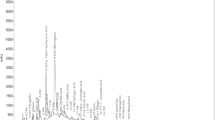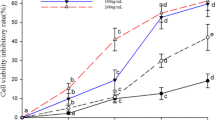Abstract
There is an increasing incidence of liver cancer, which is a hazard for global health. The present study was designed to evaluate possible cytotoxic, genotoxic, apoptotic, oxidant and antioxidant effects of thymol on hepatocellular carcinoma (HepG2) cell line. The cytotoxic effect of thymol on HepG2 cell line was determined by XTT test. We also used the HUVEC cell line to show whether thymol damages healthy cells. Oxidative stress level was determined with Total Oxidant Status (TOS) and Total Antioxidant Status (TAS) measurement kits. Apoptosis of cells was detected in flow cytometry with Annexin V apoptosis kit. Apoptotic gene expressions were analyzed by real-time PCR. Genotoxicity was determined by comet assay, which measures DNA damage. The thymol IC50 dose was found to be 11 μM on HepG2 cell line. This dose had no lethal effect on the healthy HUVEC cell line. While thymol significantly decreased the TOS level, it increased the TAS level significantly in HepG2 cells compared to control. Thymol significantly induced apoptosis in HepG2 cells (apoptosis rate in control group 1%, in thymol group 21%). Thymol did not alter the gene expressions of bax, bcl-2, and casp3, all of which are associated with apoptosis. Statistically significant change in favor of genotoxicity was observed in tail length measurements. Our results suggest that thymol decreases oxidative stress in HepG2 cell line, but it induces apoptosis and genotoxicity.





Similar content being viewed by others
Data availability
All data generated or analysed during this study are included in this published article.
References
Villanueva A. Hepatocellular carcinoma. N Engl J Med. 2019;380:1450–62. https://doi.org/10.1056/NEJMra1713263.
Cancer Today. https://gco.iarc.fr/today/online-analysis-pie?v=2020&mode=cancer&mode_population=continents&population=900&populations=900&key=total&sex=0&cancer=39&type=0&statistic=5&prevalence=0&population_group=0&ages_group%5B%5D=0&ages_group%5B%5D=17&nb_items=7&group_cancer=1&include_nmsc=1&include_nmsc_other=1&half_pie=0&donut=0. Accessed 31 Jan 2023.
Llovet JM, Kelley RK, Villanueva A, Singal AG, Pikarsky E, Roayaie S, et al. Hepatocellular carcinoma. Nat Rev Dis Primers. 2021. https://doi.org/10.1038/s41572-020-00240-3.
Estes C, Razavi H, Loomba R, Younossi Z, Sanyal AJ. Modeling the epidemic of nonalcoholic fatty liver disease demonstrates an exponential increase in burden of disease. Hepatology. 2018;67:123–33. https://doi.org/10.1002/hep.29466.
Parham S, Kharazi AZ, Bakhsheshi-Rad HR, Nur H, Ismail AF, Sharif S, et al. Antioxidant, antimicrobial and antiviral properties of herbal materials. Antioxidants (Basel). 2020;9:1–36. https://doi.org/10.3390/antiox9121309.
Kowalczyk A, Przychodna M, Sopata S, Bodalska A, Fecka I. Thymol and thyme essential oil-new ınsights into selected therapeutic applications. Molecules. 2020. https://doi.org/10.3390/molecules25184125.
Salehi B, Mishra AP, Shukla I, Sharifi-Rad M, del Mar Contreras M, Segura-Carretero A, et al. Thymol, thyme, and other plant sources: health and potential uses. Phytother Res. 2018;32:1688–706. https://doi.org/10.1002/ptr.6109.
Hashemipour H, Kermanshahi H, Golian A, Veldkamp T. Effect of thymol and carvacrol feed supplementation on performance, antioxidant enzyme activities, fatty acid composition, digestive enzyme activities, and immune response in broiler chickens. Poult Sci. 2013;92:2059–69.
Zarrini G, Delgosha ZB, Moghaddam KM, Shahverdi AR. Post-antibacterial effect of thymol. Pharm Biol. 2010;48:633–6.
Nieto G. Biological activities of three essential oils of the lamiaceae family. Medicines. 2017;4:63.
Horvathova E, Navarova J, Galova E, Sevcovicova A, Chodakova L, Snahnicanova Z, et al. Assessment of antioxidative, chelating, and DNA-Protective effects of selected essential oil components (Eugenol, Carvacrol, Thymol, Borneol, Eucalyptol) of plants and intact rosmarinus officinalis oil. J Agric Food Chem. 2014;62:6632–9.
Liang D, Li F, Fu Y, Cao Y, Song X, Wang T, et al. Thymol inhibits LPS-stimulated inflammatory response via down-regulation of NF-κB and MAPK signaling pathways in mouse mammary epithelial cells. Inflammation. 2014;37:214–22.
Islam MT, Khalipha ABR, Bagchi R, Mondal M, Smrity SZ, Uddin SJ, et al. Anticancer activity of thymol: a literature-based review and docking study with Emphasis on its anticancer mechanisms. IUBMB Life. 2019;71:9–19. https://doi.org/10.1002/iub.1935.
Li Y, Wen J, Du C, Hu S, Chen J, Zhang S, et al. Thymol inhibits bladder cancer cell proliferation via inducing cell cycle arrest and apoptosis. Biochem Biophys Res Commun. 2017;491:530–6. https://doi.org/10.1016/j.bbrc.2017.04.009.
De La Chapa JJ, Singha PK, Lee DR, Gonzales CB. Thymol inhibits oral squamous cell carcinoma growth via mitochondria-mediated apoptosis. J Oral Pathol Med. 2018;47:674–82. https://doi.org/10.1111/jop.12735.
Hassan HFH, Mansour AM, Salama SA, El-Sayed ESM. The chemopreventive effect of thymol against dimethylhydrazine and/or high fat diet-induced colon cancer in rats: relevance to NF-κB. Life Sci. 2021. https://doi.org/10.1016/j.lfs.2021.119335.
Aghamohammadi A, Hosseinimehr SJ, Ghasemi A, Azadbakht M, Pourfallah TA. Radiosensitization effects of a Zataria multiflora extract on human glioblastoma cells. Asian Pac J Cancer Prev. 2015;16:7285–90. https://doi.org/10.7314/APJCP.2015.16.16.7285.
Lee KP, Kim JE, Park WH, Hong H. Regulation of C6 glioma cell migration by thymol. Oncol Lett. 2016;11:2619–24. https://doi.org/10.3892/ol.2016.4237.
Qoorchi Moheb Seraj F, Heravi-Faz N, Soltani A, Ahmadi SS, Shahbeiki F, Talebpour A, et al. Thymol has anticancer effects in U-87 human malignant glioblastoma cells. Mol Biol Rep. 2022;49:9623–32. https://doi.org/10.1007/s11033-022-07867-3.
Özgen Ö, Özen Eroğlu G, Küçükhüseyin Ö, Akdeniz N, Hepokur C, Kuruca S, et al. Vitamin D increases the efficacy of cisplatin on bladder cancer cell lines. Mol Biol Rep. 2023. https://doi.org/10.1007/s11033-022-08044-2.
Arzumanian VA, Kiseleva OI, Poverennaya EV. The curious case of the HepG2 cell line: 40 years of expertise. Int J Mol Sci. 2021. https://doi.org/10.3390/ijms222313135.
Sharifi-Rad J, Sharifi-Rad M, Hoseini-Alfatemi SM, Iriti M, Sharifi-Rad M, Sharifi-Rad M. Composition, cytotoxic and antimicrobial activities of Satureja intermedia C.A. Mey essential oil. Int J Mol Sci. 2015;16:17812–25. https://doi.org/10.3390/ijms160817812.
Fitsiou E, Anestopoulos I, Chlichlia K, Galanis A, Kourkoutas I, Panayiotidis MI, et al. Antioxidant and antiproliferative properties of the essential oils of Satureja thymbra and Satureja parnassica and their major constituents. Anticancer Res. 2016;36:5757–63. https://doi.org/10.21873/anticanres.11159.
Ferraz RPC, Bomfim DS, Carvalho NC, Soares MBP, Da Silva TB, Machado WJ, et al. Cytotoxic effect of leaf essential oil of Lippia gracilis Schauer (Verbenaceae). Phytomedicine. 2013;20:615–21.
Kavak E, Mutlu D, Ozok O, Arslan S, Kivrak A. Design, synthesis and pharmacological evaluation of novel Artemisinin-Thymol. Nat Prod Res. 2020. https://doi.org/10.1080/14786419.2020.1865954.
Lv R, Chen Z. Thymol inhibits cell migration and invasion by downregulating the activation of PI3K/AKT and ERK pathways in human colon cancer cells. Trop J Pharm Res. 2018;16:2895–901. https://doi.org/10.4314/tjpr.v16i12.13.
Elshafie HS, Armentano MF, Carmosino M, Bufo SA, De Feo V, Camele I. Cytotoxic activity of Origanum vulgare L. on hepatocellular carcinoma cell line HepG2 and evaluation of its biological activity. Molecules. 2017;22:1435. https://doi.org/10.3390/molecules22091435.
Ozkan A, Erdogan A. A comparative study of the antioxidant/prooxidant effects of carvacrol and thymol at various concentrations on membrane and DNA of parental and drug resistant H1299 cells. Nat Prod Commun. 2012;7:1557–60. https://doi.org/10.1177/1934578X1200701201.
Palabiyik SS, Karakus E, Halici Z, Cadirci E, Bayir Y, Ayaz G, et al. The protective effects of carvacrol and thymol against paracetamol-induced toxicity on human hepatocellular carcinoma cell lines (HepG2). Hum Exp Toxicol. 2016;35:1252–63. https://doi.org/10.1177/0960327115627688.
Shettigar NB, Das S, Rao NB, Rao SBS. Thymol, a monoterpene phenolic derivative of cymene, abrogates mercury-induced oxidative stress resultant cytotoxicity and genotoxicity in hepatocarcinoma cells. Environ Toxicol. 2015;30:968–80. https://doi.org/10.1002/tox.21971.
Kaloni D, Diepstraten ST, Strasser A, Kelly GL. BCL-2 protein family: attractive targets for cancer therapy. Apoptosis. 2023;28:20–38. https://doi.org/10.1007/s10495-022-01780-7.
Raji-Amirhasani A, Khaksari M, Soltani Z, Saberi S, Iranpour M, Darvishzadeh Mahani F, et al. Beneficial effects of time and energy restriction diets on the development of experimental acute kidney injury in rat: Bax/Bcl-2 and histopathological evaluation. BMC Nephrol. 2023;24:59. https://doi.org/10.1186/s12882-023-03104-6.
Salakou S, Kardamakis D, Tsamandas A, Zolota V, Apostolakis E, Tzelepi V, et al. Increased Bax/Bcl-2 ratio up-regulates caspase-3 and increases apoptosis in the thymus of patients with myasthenia gravis. In Vivo (Brooklyn). 2007;21:123–32.
Zhu L, Han MB, Gao Y, Wang H, Dai L, Wen Y, et al. Curcumin triggers apoptosis via upregulation of Bax/Bcl-2 ratio and caspase activation in SW872 human adipocytes. Mol Med Rep. 2015;12:1151–6. https://doi.org/10.3892/mmr.2015.3450.
Roos WP, Kaina B. DNA damage-induced cell death: from specific DNA lesions to the DNA damage response and apoptosis. Cancer Lett. 2013;332:237–48.
Sancar A, Lindsey-Boltz LA, Ünsal-Kaçmaz K, Linn S. Molecular mechanisms of mammalian DNA repair and the DNA damage checkpoints. Ann Rev Biochem. 2004;73:39–85. https://doi.org/10.1146/annurev.biochem.73.011303.073723.
Roos WP, Kaina B. DNA damage-induced cell death by apoptosis. Trends Mol Med. 2006;12:440–50.
Shekh R, Tiwari RK, Ahmad A, Ahmad I, Alabdallah NM, Saeed M, et al. Ethanolic extract of Coleus aromaticus leaves impedes the proliferation and instigates apoptotic cell death in liver cancer HepG2 cells through repressing JAK/STAT cascade. J Food Biochem. 2022. https://doi.org/10.1111/jfbc.14368.
Acknowledgements
The summary of this publication was presented online with an oral presentation at the " Turkish Society of Physiological Sciences, 46th National Physiology Congress". In addition, the abstract was published in the journal "Acta Physiologica" with the title "Cytotoxic, Genotoxic, Apoptotic, Oxidant and Antioxidant Effects of Thymol on Hep-G2 Cell Line".
Funding
This study was supported by Pamukkale University Scientific Research Projects Coordination Unit through project number 2021BSP009.
Author information
Authors and Affiliations
Contributions
All authors contributed to the study conception and design. Material preparation, data collection and analysis were performed by FA, MTA and MS. The first draft of the manuscript was written by FA and all authors commented on previous versions of the manuscript. All authors read and approved the final manuscript.
Corresponding author
Ethics declarations
Conflict of interest
The authors have no relevant financial or nonfinancial interests to disclose.
Consent to participate
All authors consent to participate in this article.
Consent for publication
All authors consent to the publication of this article.
Ethical approval
Not applicable.
Additional information
Publisher's Note
Springer Nature remains neutral with regard to jurisdictional claims in published maps and institutional affiliations.
Rights and permissions
Springer Nature or its licensor (e.g. a society or other partner) holds exclusive rights to this article under a publishing agreement with the author(s) or other rightsholder(s); author self-archiving of the accepted manuscript version of this article is solely governed by the terms of such publishing agreement and applicable law.
About this article
Cite this article
Altintas, F., Tunc-Ata, M., Secme, M. et al. The anticancer effects of thymol on HepG2 cell line. Med Oncol 40, 260 (2023). https://doi.org/10.1007/s12032-023-02134-2
Received:
Accepted:
Published:
DOI: https://doi.org/10.1007/s12032-023-02134-2




